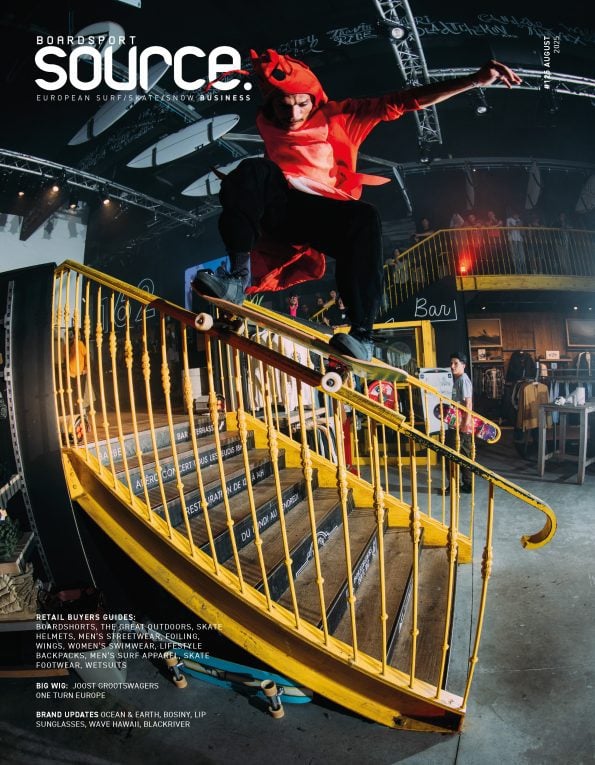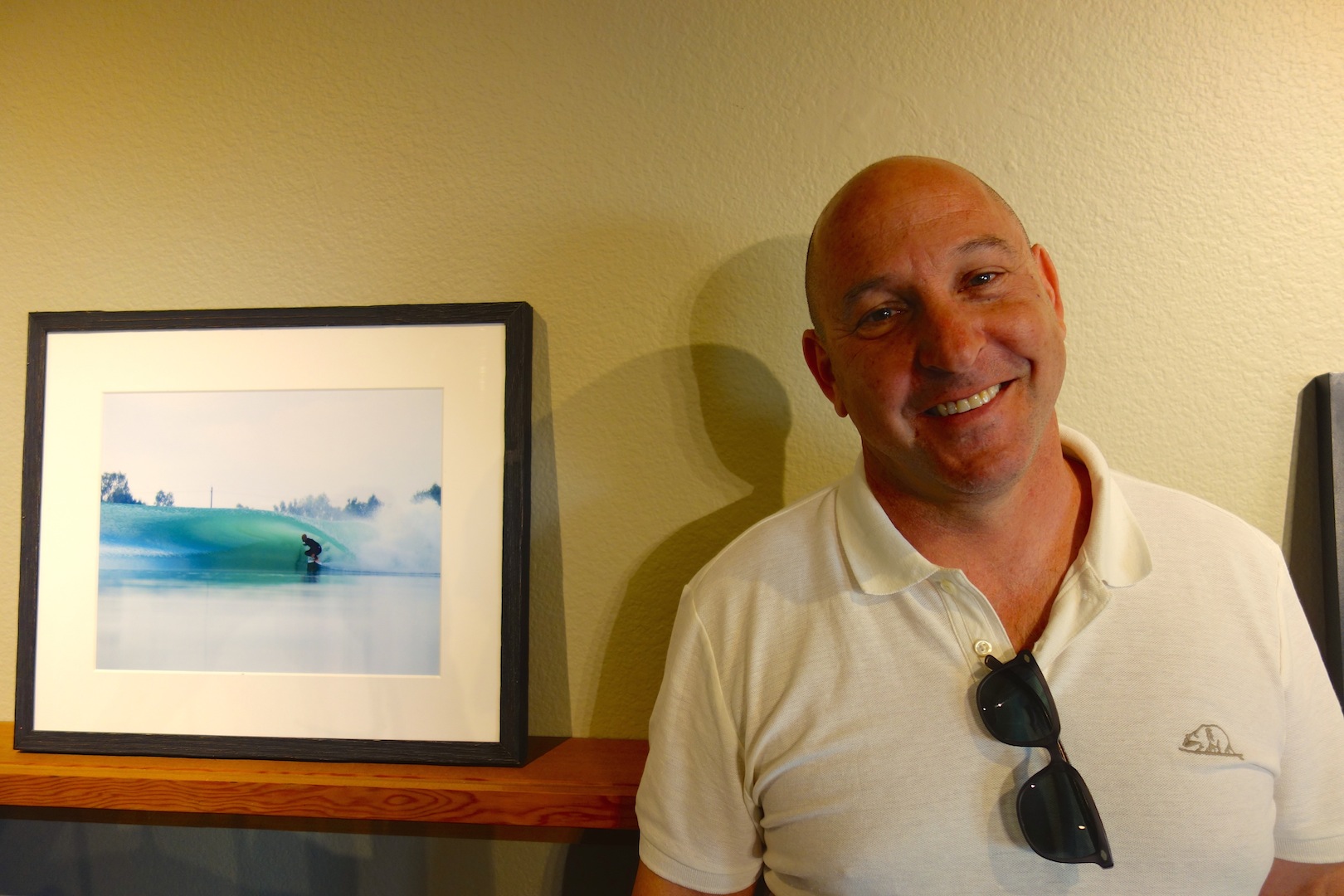
Exclusive: Kelly Slater Wave Co’s New President Talks Business & Olympics
Following on from our exclusive, in-depth interview with World Surf League CEO, Sophie Goldschmidt, we have another industry first as we speak with Kelly Slater Wave Co.’s newly appointed President.
Nick Franklin joins KS Wave Co. with 18 years of experience at Disney under his belt, a company renowned for its innovative consumer experience visitor attraction, Disneyland – a part of the business Nick worked extensively in. Launching in 2015, KS Wave Co. garnered spectacular global interest from both outside the surfing world and in – the most decorated surfer in history had created a perfect, man-made, barrelling wave.
The company was acquired by the World Surf League in 2016 and after the Surf Ranch Pro successfully hosted the WSL’s first ever Championship Tour stop at an artificial wave in September 2018, and with the 2020 Olympics just around the corner, Franklin’s taken charge at a momentous time in the history of surfing.
SOURCE editor Harry Mitchell Thompson met with Nick while at the Surf Ranch Pro in Lemoore, California to discuss Franklin’s history with Disney and his transferable skills; the wave pools arms race; the Kelly Slater Wave Co roll-out plan, business model and data capturing, and we of course dig deep into the Big O.
“Walt’s vision was about bringing amusement to a lot of people in a lot of places, and our vision is to bring surfing to a lot of people in a lot of places.”
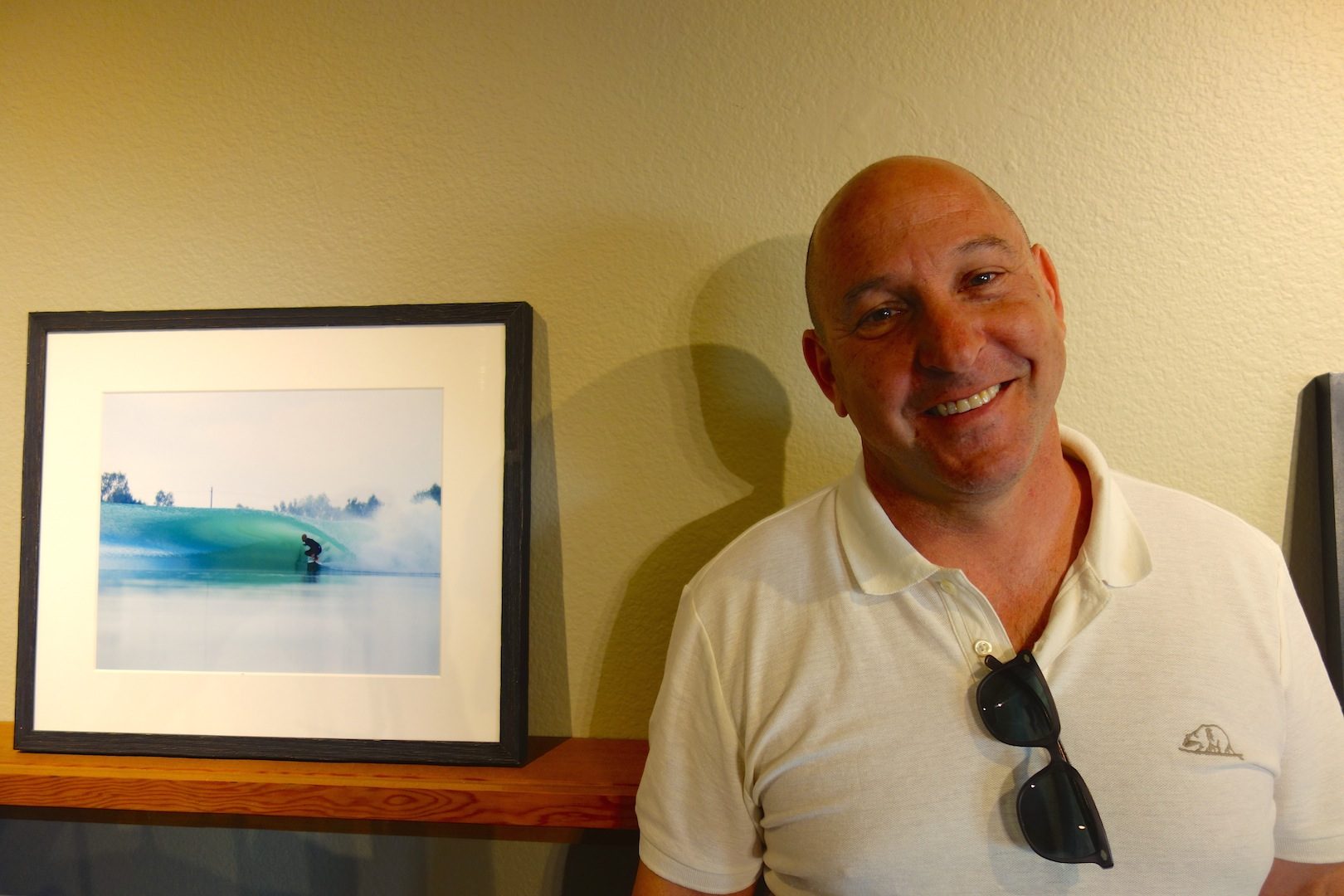
Nick Franklin, KS Wave Co President. Photo HMT,
Could you tell us a bit about yourself and your background?
I come from a career at the Walt Disney company. I was at Disney for eighteen years and I had a chance to work on the Disney theme parks business as well as corporate strategy, global development, real estate development, a number of operations on the theme park side and customer experience. I really had a chance to do a large range of things at Disney and took a little bit of a detour, worked for a home building company for a couple of years to try something very different, and realized I didn’t really love that. What I really love is entertainment and hospitality, fantastic experience and had the opportunity to come and join the WSL and the Wave Company, and have now been here for just over two months, and it’s been phenomenal. I’m having far more fun than I should ever be allowed to and actually have them pay me. It’s amazing, the experience is fantastic, this venue as I hope you’ve seen here, is spectacular and while it’s amazing when we put on an event like this, it’s even more amazing when we have other uses. Whether that’s companies in for meetings or private use or families coming through. It’s really a very special place.
Do you surf?
I am just learning how to surf. I am the perfect guinea pig for this place. Which is I’m a fifty year old guy, former rugby player. So I still think of myself as an athlete.
Rugby and not American football?
No, rugby. My parents moved to the U.K. when I was in high school, so I learned how to play rugby. I was the scrum-half and fly-half. My mother lives in Cornwall. My father in Fulham.
The HQ for KS Wave Co is down in Solana Beach, California?
So I actually split my time. One of the things that I’ve really been focused on is bringing the Wave Co and the WSL closer together. That’s part of what Sophie (Goldschmidt, WSL CEO) wanted me to do in bringing me into this role. So I actually split my time between the WSL headquarters in Santa Monica and the KS Wave Co Headquarters in Solana Beach.
Could you talk me through the recruitment process for KS Wave Co? How did you find out about the role, were you headhunted?
I was brought in. There was a search that WSL was doing to find the new president of Wave Co. They hired a recruiter, somebody that had happened to know me well from other things that they had talked to me about in the past, and they called me up and said this is something you should take a look at. And when I first looked at it, it sounded really cool and the more I dug into it, the more layers I peeled back, the more compelling it got, the cooler it got, the more fun it got. When I was here for the Founders’ Cup (inaugural competition at Surf Ranch) in May I was still in the recruitment process. And I saw the event and I said, “Okay, I’m done, where do I sign”.
Million dollar question – when or is the Surf Ranch going to open to the public?
So, we are continuing to work on all the different use cases. We already host companies and individuals. Obviously we don’t have very many days right now, because we are so focused on the events that we’re doing for the WSL but we are also so focused on continuing to push the technology. But as we go into 2019, we are going to look at different models for how the facility can be used, but we’re already bringing in community groups and companies. We’re doing special events, a lot of surf training is the future for us.
What do you mean by surf training – national team training?
The Australian Olympic team has been in. We’ve had other teams, high school teams, collegiate teams. Other Olympic teams that have expressed interest. And as we have more capacity we absolutely want to make this venue available for that.
One of the things we see as being incredibly compelling is that this is a surf progression venue. For myself as a brand new surfer, all the way to the best surfers in the world. We had some of the Australian Olympic team talk about getting more progression in three hours here than they would get in six months in the ocean. Really, a phenomenal level of data capture thanks to the repetition. Imagine for the Olympians, with their coaches on the back of a jet ski, they’re surfing the right, the coach is on the back of the ski with an iPad, videoing them. Once the wave is finished, they sit down and as they’re coming back to that end of the basin with their coach holding onto the back of the ski, they’re going through the run they just did, and then they go surf the same wave again, and they can make adjustments. “Oh, I did one extra pump here, I didn’t need that. I should drop into the barrel earlier. I missed the window for this air.”
It’s amazing to watch them make progressions just like that *clicking fingers*.
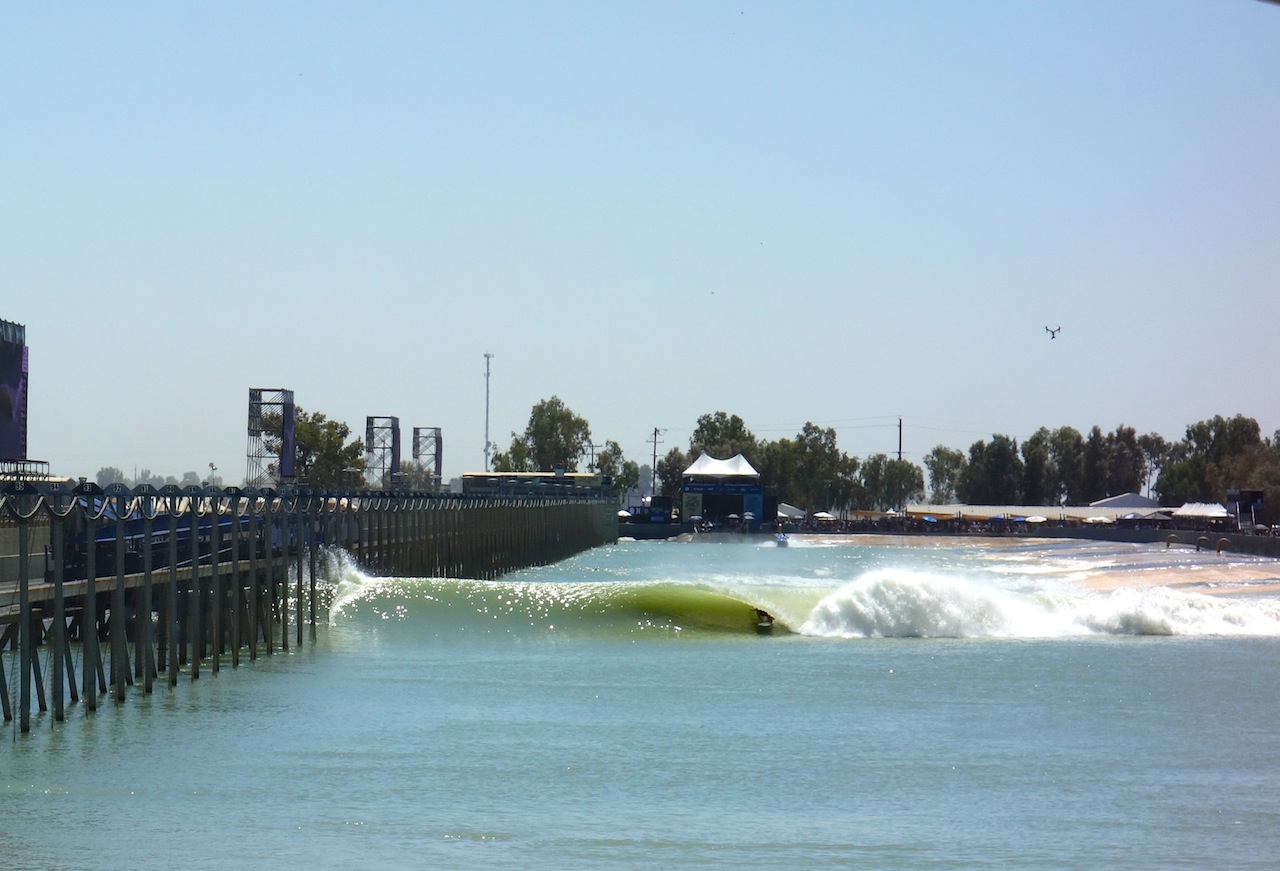
Surf Ranch Pro 2018 Event Winner Gabriel Medina slotted. Photo HMT
And it must be great for product testing as well.
It’s fantastic, and we’re product testing everything from the wave itself, to video, to data capture, to partners on the board side, partners on the wearable technology side. We don’t need it right now because it’s a hundred degrees outside, but as we go into the winter season we’ll also be putting wetsuits through their paces.
It’s a great venue to trial anything. We’re using it on the WSL side from a broadcast standpoint, we’re doing things at this event that we haven’t done before, and we want to continue to push the envelope. This is a prototype venue to push every aspect of the sport forward, we hope.
What months of operation are you working on?
We’ve had it mixed for the past year. As we go into the next year, our plan is to be running the full year. Obviously when it’s January and it’s freezing cold, and we have fog in the morning, our hours of operation are a little bit less. So we’ll use some seasonal variation, but our intent is that these are, where possible, year-round facilities.
How will your background at Disney set you in good stead for what you’ll be doing for KS Wave Co?
I had the opportunity with Disney to work on facilities around the world, to work on the development of theme parks, the establishment of every layer of the brand, truly around the world. I have an extraordinarily high level of guest experience. And I think all of those things translate into this business.
We have a vision for wave basins being part of the surf market around the world. Key markets for the WSL, where we obviously have an interest in is Australia and Brazil, a connection to the Olympics in Tokyo, in Europe and back to Los Angeles. But also, because of the deep nature of this technology – here we’re sitting 100 miles inland from the nearest break. That means we can effectively bring waves just about anywhere, and part of our vision is that we can share surfing with a lot of people in a lot of places, and when I think about things from a Disney standpoint, that was something that Disney always talked about doing.
Disneyland in California is built in the middle of former orange groves, and in Orlando it’s in a swamp, and in Tokyo, it’s on reclaimed land. Walt’s vision was about bringing amusement to a lot of people in a lot of places, and our vision is to bring surfing to a lot of people in a lot of places.
Can we talk about customer data and how you plan on using that, and using what they’re up to, to better their experience in the future?
I don’t think we want to become a waterpark where people are coming for an hour. That’s not the level of experience we want to create. For us the data is less about individual data, what else they’re doing in the world. It’s more about their individual progression from a surfing standpoint. So what we absolutely want to be able to do is with every wave that you surf here, we’re going to give you a video of that wave. We’re going to provide access to the training you do here to allow you to continue your surf progression in other places. So really for right now, our focus is on that kind of data.
It’s performance data, it’s your individual surf progression data more so than what people generally think about customer data. That being said, we do survey our customers. We use something called Net Promoter score, which is a method of basically saying on a scale of one to ten – how likely are you to recommend this to somebody else? The consulting company that developed it says that if you score an eight, nine, or a ten, you would be a recommender. One, two, three, or four, you’re a detractor. Anything in the middle, you’re neutral. Most companies are really happy if that number is positive. Disney’s a pretty amazing brand and they have a Net Promoter score at Walt Disney World in Orlando of around 72/73. Which is incredibly positive.
Our Net Promoter score here at Surf Ranch Lemoore, is 91. Which is a mind boggling number.
We have 91% recommenders, we have 9% neutral and we have no detractors. We’ve had people come here and almost lose the ability to express the life changing nature of what they experienced. We’ve had wounded warriors and we’ve had a blind surfer who came and surfed. We’ve had young kids who are cancer survivors, we had a gentleman who was a surfer until he was 16, and then was paralyzed and hadn’t been on a wave, and is now in his forties, or fifties. And we got him off a wheelchair and into a wave with one of our coaches, because we have a controlled environment. What was really interesting was it wasn’t his reaction as much as it was watching his wife’s on the side, that was amazing. She teared up. So it’s a pretty impactful place. We’ve also had multi-generational families here too.
What you’re seeing here (at the Surf Ranch Pro) is the competition wave. But we can turn that down to a much more manageable wave, we call it the Waikiki wave. We can put eight people on soft tops, and they’re cruising along, and you get everything from a grandmother to her granddaughter, and they can be on the wave together.
Let’s talk about the business model side of things – at the moment it’s an arms race in the wave pool world with KS Wave Co., Wavegarden, Waco, Surf Lakes etc. I’ve been to the one in Snowdonia, Wales and it’s interesting to see that they’re making a good go of their business model, with accommodation pods beside the lake, a ‘crash and splash’ area for non-surfers, skate ramp, restaurant, shop etc. Will you follow down the same business model?
I don’t think we want to go all the way to that model. We already have the Perkins Lake, the next-door lake to the basin. There we’ve got SUPs, swimming and wake surfing. We’ve had a group of families and we had people in inner tubes bouncing around as the surf went through. If you want to bring a group, we want to make this place incredibly fun for even the people that aren’t surfing. Whether you’re in the basin or out of the basin.
We won’t try to get thousands of people through here in a day. Well, obviously, on a day like today (Saturday of Surf Ranch Pro 2018) we have 5,000 people, but that’s for a big event. In our core business model, we might want to get 100-150 people in for an event. Some portion of them will be surfing, some portion will be doing other things. We’ve already had company events where we’ve had between 100-120 on property for the day.
For us, the experience is less about the quick hit, “I wanna get in a splash around”, and more about the overarching experience. I think we’ll break from having it be mostly full-day experiences, into partial-day experiences. How far we break that down is something we’re still exploring.
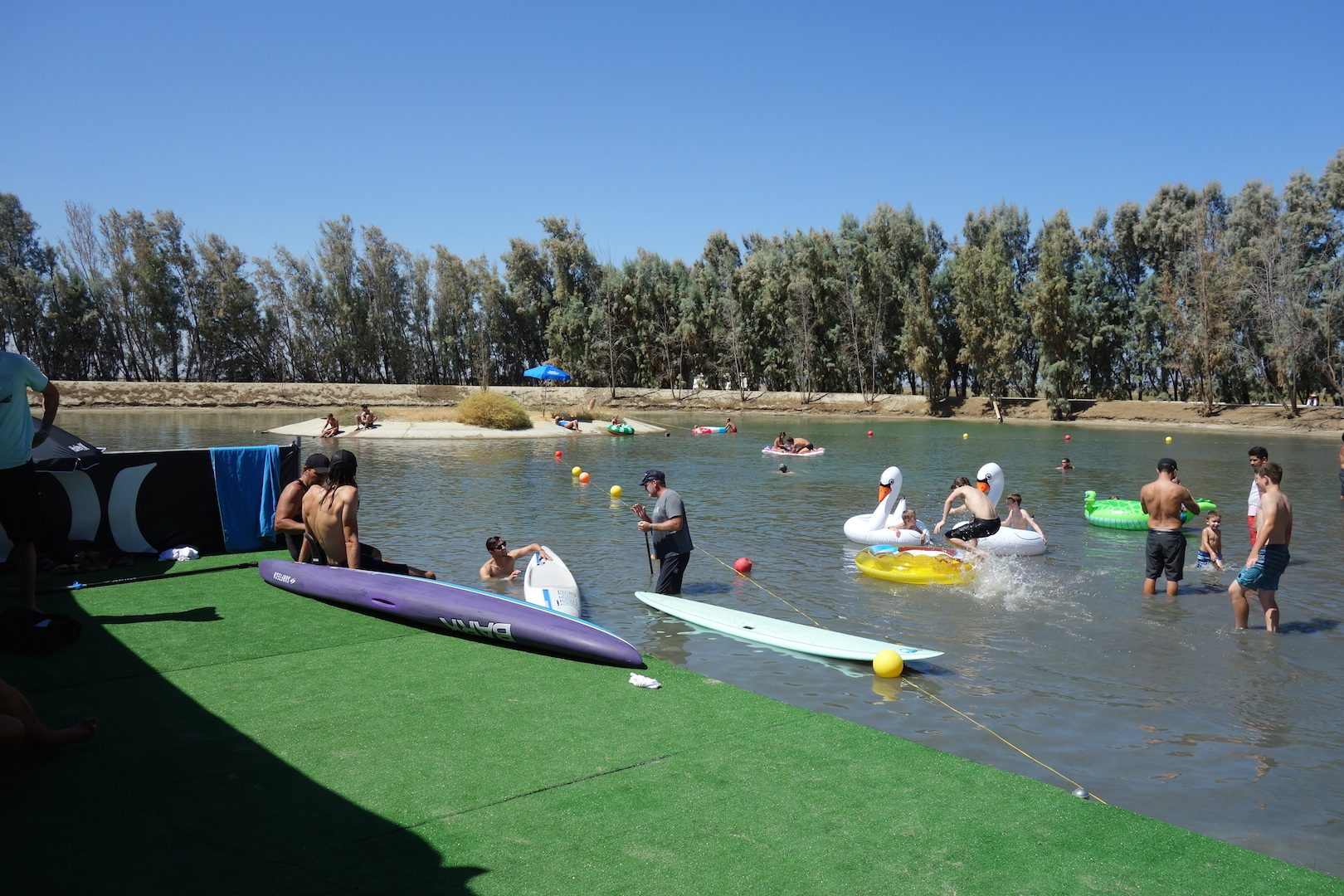
Perkins Lake. Photo HMT.
Can you talk any more about a roll-out plan?
I can’t talk specifically about where the next one will be. What I can tell you is that we have a set of key strategic markets. One of the great things that we have, that no one else has, is that we are part of the WSL. So, we have the tour, we have the best surfers in the world. One of the things that’s crucially important to us is the need to support that with events like this, in other geographies, as add-ons to the ocean events. Not to replace the ocean events, but to expand what we’re capable of doing from the tour standpoint.
So, key surf markets; Australia and Brazil are obviously very high priorities for us. Surfing going into the Olympics means Tokyo, Paris and Los Angeles are very important for us. The east coast of the US is also a big surf market. North America is a big broadcast market. Then we think about other markets – the rest of Asia, other parts of Europe. Big opportunities to bring surfing to places, either where there aren’t always consistent waves, or where there just aren’t waves because you’re kind of stuck, like here (Lemoore).
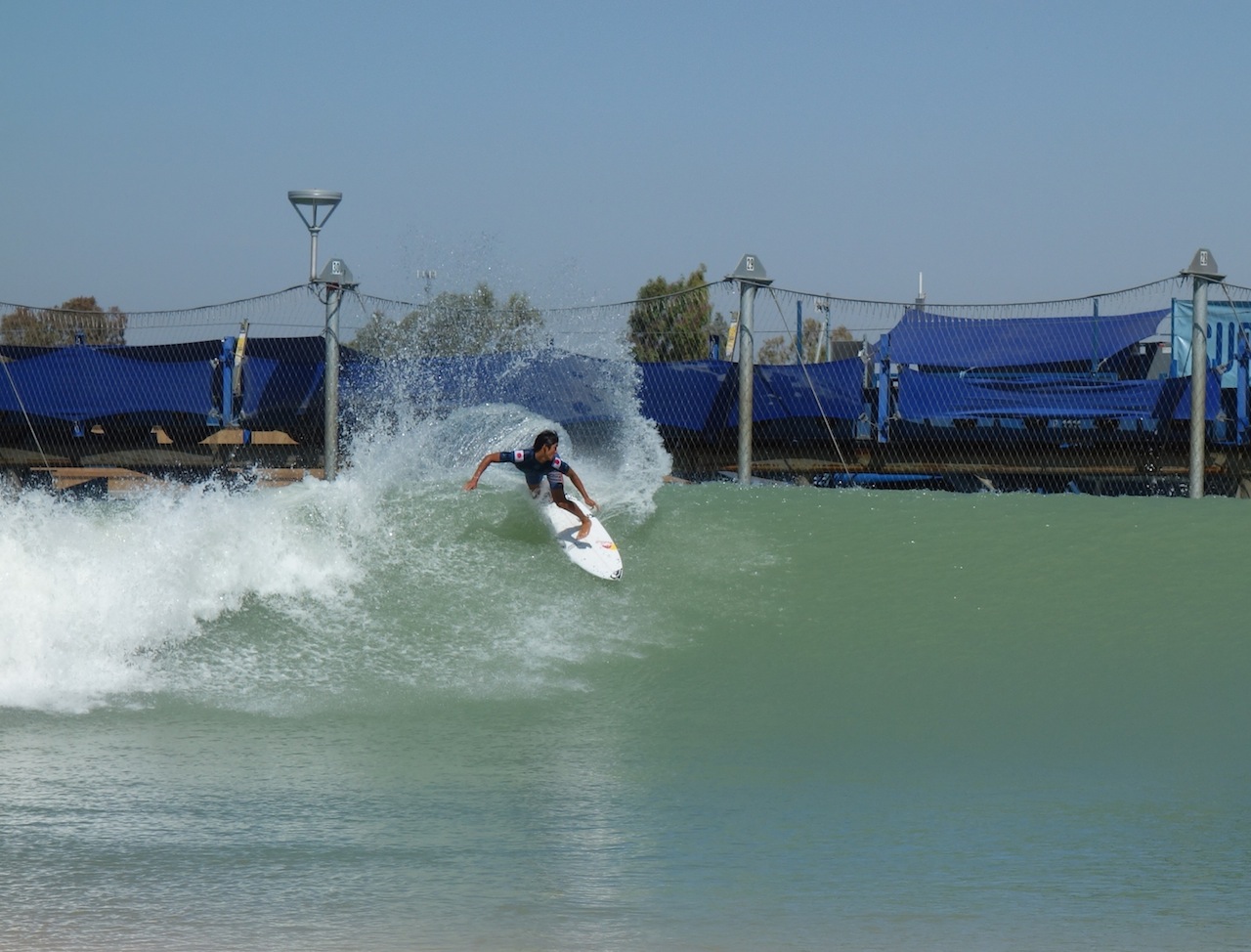
Kanoa Igarashi. Photo HMT
2020 Olympics and surf pools. What can you tell me?
Well, the official venue is going to be in Shiba, Tokyo. That’s what the official party line is right now. Even if they wanted to, we don’t have a venue constructed in Tokyo right now, so it’s not like we have an operating one and we’re standing there saying: “Why aren’t we making this the official venue?” We do have a project that we are looking at very seriously, which we will do whether or not anything changes with regard to the Olympics. We think it’s a really important opportunity for us. We hope to do that project in a timely manner, and see where we get to.
Tokyo is very important for us, and the Olympics are very important for us, whether we have a venue or not. Our athletes are going to be there, the WSL is keenly interested for the sport of surfing to have a great showing in Tokyo.
Obviously we would love to have the event in one of our venues, if and when we have a venue that’s up and running. The only thing we can control is pursuing having a venue, and then we’ll see where that goes. We also see it as an exciting opportunity regardless of what happens in Tokyo as we look towards Paris, and then Los Angeles.
There’s something really compelling about, as you’ve seen today, when it’s a one-time event, having the athletes get to work off a comparable wave, so they know whoever surfs the best that day is going win. And it takes some of the random chance of the ocean out of it. Over the course of a season, for the best surfer, the world champion should surf in many different conditions, all different breaks, and everybody thinks that continues to make the most sense. When something is one-and-done like the Olympics, you’d hate to have somebody not have a chance because they just didn’t get waves. Or you’d hate to have the entire event suffer from mediocre, mushy waves.
Looking at Tokyo and looking at the swell season, it’s the middle of summer, it could be that it’s just as flat as a pond. If this were the case and there happened to be a KS Wave pool there and ready, then you guys could say: “Hey IOC/ISA, we have a wave over here…”
From your words to the Tokyo games organizers’ ears! The only thing we can control is trying to have one of our wave stadiums up and running that we can use for WSL events, that athletes can use for training, and if and when that happens, if there’s a decision, we’d be thrilled.




